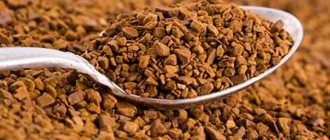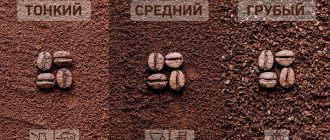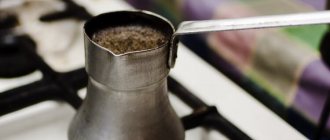Coffee lovers cannot imagine the morning without a cup of drink. Some people prefer to roast and grind coffee beans, while others brew them in ground or instant form. The taste qualities are influenced by the type and roasting of the product, and the method of its preparation. How to store coffee beans or other form after opening the package has a significant impact on maintaining its aroma and taste. This is no less significant stage than the cooking procedure.
General storage rules
The taste of coffee largely depends on the storage location, since if it is not stored correctly, it will weather and lose its aroma. If you store whole grains in a damp place, they will absorb moisture and the taste of the invigorating drink will change.
How and in what to store ground coffee
After grinding, coffee becomes more vulnerable to the external environment and easily loses its quality if storage rules are not followed. The main condition is container. It should close tightly and be opaque, since exposure to direct sunlight or lamp rays will negatively affect the consistency. Store the jar in dry places, away from the stove and sink.
How and in what to store coffee beans
Store beans in sealed jars, as roasted seeds quickly lose flavor when exposed to air. The jar should be hidden in a dark, but not damp place, since a thin film may appear on the grains. The taste of the drink will then become sour and bitter.
Coffee absorbs foreign odors well, so when storing it in the refrigerator, the jar should always be tightly closed.
How and in what to store coffee capsules
The capsules' warranty from the manufacturer is 2 years, but only with proper storage, namely:
- do not leave capsules in the sun;
- do not open the package in advance;
- Do not store in the refrigerator, as condensation will accumulate inside the package;
- Do not make holes in the packaging yourself, the machine will do it itself.
When purchasing capsules, carefully inspect the packaging for leaks.
How and in what to store coffee grounds
Coffee pulp is used as a fertilizer or facial scrub. It is best used fresh, but it can also be dried. The healing properties will become a little weaker, but the effect will not disappear.
First, we dry it, take paper and spread the cake around the entire perimeter so that there are no accumulations, otherwise mold will form.
The average drying time will take 2-3 days, but it needs to be stirred regularly. Store dried pulp in a closed glass or ceramic jar without direct exposure to rays and moisture.
How and in what to store instant coffee
Instant coffee is not as valued as ground or bean coffee, but it is the most common type of drink in Russia. Its aroma is not so rich, so in order to preserve the already weak smell, you need to adhere to special storage rules.
Regardless of packaging, instant coffee can be stored without loss of quality for up to 5 years, but after opening the shelf life is reduced to 6 months. To prevent the drink from losing its taste, we follow the rules:
- do not store in the refrigerator;
- do not allow direct sunlight;
- after use, close the container tightly;
- In the case of soft packaging, it is recommended to use foil as a lid.
If instant coffee becomes less aromatic, add a cinnamon branch to the jar. It will enhance the smell, but not for long.
How to store freeze-dried coffee
Freeze-dried coffee is similar to instant coffee, but it is richer and more flavorful because it is made from higher quality beans. Essentially, these are the same beans, only crushed, so we use the same storage method as for whole beans. We hide it from direct sunlight and lamp rays, keep the packaging completely sealed and do not leave it open.
The difference between a good product and a bad one
The main criterion that suggests that coffee has gone bad is the smell. Externally, the grain, ground or instant drink changes little over time. But the aroma, on the contrary, can either disappear completely or become rancid or sour. The difference in taste is also not always noticeable; moreover, drinking an expired drink in most cases is not dangerous, especially if we are talking about raw beans, and it even retains an invigorating effect due to the caffeine content.
Grain
A sign of marriage is empty and brittle grains
In addition to the obvious deterioration of the appearance of unroasted beans: mold, sour or musty odor and dried edges, a stale product reveals a lack of taste and aroma after roasting. The grains are brittle and empty inside. With high humidity, on the contrary, rotten beans may appear in the bag.
But heat-treated ones, on the contrary, only harden over time and are difficult to grind. They acquire too dark a color due to the oxidation of oily substances, which also give stale grains a rancid smell. In addition, such grains shine unnaturally and stick together.
Coffee beans affected by pests
If it’s a pity to part with roasted coffee beans that have lain idle for a long time and have lost their freshness and aroma, you can use them to decorate interior items: photo frames, coasters, flower pots, flower vases, etc. This will give ordinary items an interesting twist, and the grains will not go to waste.
Ground
Stale powder will have a non-uniform consistency - lumps in the packaging arise due to long-term storage at high humidity, in addition, the coffee can “melt” and solidify into a single solid mass. It is especially unpleasant if there are any living creatures in the ground drink; this type of coffee is the most suitable for the reproduction of unpleasant creatures.
Soluble
The most resistant type of coffee drink to changes over time. Obvious signs of an expired product are traces of mold and mildew.
Clumping and caking of the granules will also indicate that the shelf life has expired. The smell of stale instant coffee becomes sour or is completely lost. But unpleasant living creatures are found in it extremely rarely, this is due to the peculiarities of production: the low content of essential oils and chemical additives repel parasites.
Currently, there are not a single case of poisoning from stale coffee. However, this does not mean that it can be stored carelessly and for a long time. As with any organic product, toxins accumulate and chemical reactions occur. Of course, one cup of such a drink will not do much harm, but systematic use can lead to problems with digestion and liver.
Where to store coffee
To prevent coffee from losing its taste, you must strictly follow the storage rules, otherwise the taste will resemble a cheap coffee drink.
Can coffee be stored in the refrigerator?
The refrigerator cannot be considered a good place to store coffee, for several reasons:
- condensation collects in foil packages and glass containers;
- if coffee absorbs moisture, it will no longer be possible to extract it;
- in addition to moisture, the drink absorbs foreign odors well, of which there is plenty in the refrigerator;
- To increase the shelf life of coffee, you will need an air temperature of -40 degrees or more, which the refrigerator does not have.
With frequent temperature changes, coffee will be compacted in the packaging, creating lumps and losing its aesthetic appearance.
Can grains be stored in the freezer?
According to experts, the best coffee comes from fresh, recently roasted beans. However, freezing has its advantages.
When grains are stored at a temperature of -50 degrees and below, the grains retain their taste, and after defrosting and using, their taste not only intensifies. Frozen grains have been shown to create a more balanced flavor, indicating less use per serving.
Good freezing qualities only apply to very low temperatures, and the freezer compartment of a household refrigerator is not able to improve this effect.
Where to store ground coffee in an open pack
The best place would be the kitchen cabinet, but various spices and seasonings should not be near the open packaging, otherwise the coffee will absorb all the assorted ingredients. There should be no stove or sink nearby, as the steam from the hot water will transfer moisture to the ground grains. Make sure that direct sunlight does not fall on the pack of coffee.
Is it possible to store coffee in a can?
It all depends on the tightness of the can itself. Not all metal containers can close tightly, and to lose the aroma you only need a micro-crack. At the same time, the tin can can easily become deformed, and this is another step towards loss of taste. But tin also has its advantages. It does not let the sun's rays through and, with good sealing, perfectly retains the aroma.
Consequences
Expired coffee does not benefit the body, but does not create a situation of poisoning. In this case, the drink will have a different taste, aroma, which will not bring pleasure from consumption. When opening the package, the contents are poured into a hermetically sealed tin can.
The grains are stored wrapped in foil. This method allows you to preserve the taste for 3 months. It is recommended to grind them before brewing. Expired sticks (3-in-1 packages) should be excluded from the diet. This rule also applies to the soluble form. Green grains, despite the expiration date, can be fried, brewed, and eaten.
How long does coffee last?
The shelf life depends on the location and type of the drink itself. If you are in places with open rays or high moisture, coffee will quickly lose its quality. If the storage location is used under all conditions, then the period will depend on the degree of grinding and the type of grains.
Shelf life of coffee in unopened packaging
It should be understood that expiration date and shelf life are slightly different concepts. The expiration date indicates the period of preservation of all the qualities of the drink, but the shelf life indicates the time for use, and if it passes, the product will need to be thrown away.
Instant coffee has the longest shelf life - up to 5 years, followed by capsule type - up to 2 years, whole or ground beans - up to six months. After opening the package, a new storage period begins, which is significantly reduced.
Shelf life of unroasted coffee
In the storage category, unroasted coffee is superior to heat-processed beans because its shelf life is significantly longer. Whole raw coffee beans often last up to 1 year, and some varieties last up to three years. In five years they may not disappear, but they will lose their taste.
Before purchasing, read the packing date on the packaging - it will indicate the exact time of collection. When buying green coffee beans by weight, pay attention to their appearance, this will allow you to approximately know their age:
- the grains must be whole, without a large number of chips;
- the outer shell should be velvety and uniform, without any special shades;
- the smell should not be too rich, but on the contrary, with herbal undertones.
If the grains differ in appearance, it means they were collected at different times, and accordingly their quality will be low.
Shelf life of roasted coffee beans
Roasted grains are inferior in terms of time to green ones, so to maximize the preservation of taste, observe the required conditions. Most often, roasted coffee is stored in three types:
- Unsealed container. A simple and practical way to store small quantities of grains. The maximum shelf life is 14 days.
- Sealed paper bags. Subject to the rules of absence of moisture, direct sunlight and sealing, the maximum shelf life will be 6 months.
- Heat sealable container. These bags are designed for storing coffee beans. They are equipped with special filters for removing gases; in addition to their high tightness, the shelf life reaches 1 year.
How long can coffee beans be stored in an open package?
Once the package is opened, the shelf life is significantly reduced. When exposed to air, roasted grains quickly lose their taste, so it is recommended to use them within 14 days. You can extend their storage by 3-5 days by pre-portioning them in an airtight container.
Average shelf life of coffee beans
There are established shelf life periods for coffee, which must be followed despite the manufacturer’s statements:
- green grains – up to 1 year;
- roasted grains after opening – up to 14 days;
- in vacuum packaging – one and a half years;
- in a tight sealed container - up to 1 year.
The above average periods are achieved only if storage rules are observed.
Shelf life of green coffee beans
Green coffee is often purchased in large quantities as it can keep its quality for about 12 months. When purchasing in closed bags, the date of packaging will be indicated, but when purchased in bulk, you will have to independently determine the quality and age of the grains.
Fresh green seeds have a herbaceous smell and velvety color, without a film. They should feel loose and easy to break to the touch. However, the main indicator is one color, since grains of different shades indicate different ages. Their lifespan will be shorter and, accordingly, the aroma and taste will be weaker.
How long can coffee beans be stored in a glass jar?
When pouring grains into a glass jar, there will be an interaction with oxygen that cannot be prevented. Gases will disappear from fresh beans after roasting, which is a good indicator, but interaction with oxygen will start the oxidation process and, over time, the taste will change for the worse.
The shelf life in a glass jar is practically no different from other packaging, the main thing is that it is not exposed to the sun's rays. It should also not be placed in the refrigerator due to condensation.
How long does coffee last in a thermos?
The shelf life of the aroma and taste of coffee in a thermos depends on the quality of the container itself and its ability to retain heat. The taste will remain until the water cools. You can brew coffee immediately or take boiling water with you and brew each portion separately.
The second option will better reflect the taste of the drink, since it will be freshly brewed, but it is also less practical. As the water cools, the coffee will brew weaker and, accordingly, the taste will become worse. Choose the most profitable option for yourself.
How to store coffee grounds for scrub
It is recommended to use coffee grounds immediately, until they are fully saturated with all qualities. If you don’t have this option, then put it in a jar and put it in the refrigerator. The recommended period of use is up to 7 days, otherwise there will be a weak effect. Alternatively, it can be tightly sealed and placed in the freezer. In this case, the shelf life will increase four times, but you should not keep the coffee scrub in the freezer.
You can dry the grounds and later use them as tinctures, combining them with beneficial herbs.
Coffee has never lost its popularity, and judging by its variety of uses, it is only gaining it. In Russia, the most common type of coffee is instant coffee, made from low-grade beans. Its storage conditions are less strict, but the taste is far from true.
To experience the real aroma of an invigorating drink, take freshly roasted beans, process them in a coffee grinder and make coffee, after which you will definitely not want to go back to instant.
Cappuccino and latte
With dairy drinks, things are more complicated than you might think. The lifespan of cappuccino and latte is just a couple of minutes. After this, the drink begins to flake off, lose its foam and change in taste, turning into a dull Americano with milk. If you want cappuch to remain yourself, please start drinking it right away.
Of course, not everyone notices this problem. Those who extinguish the natural taste with syrups and sugar may pay little attention to the changes. But if we mean the right cappuccino, which is not a shame to show at the barista championship (there are such), then the drink is not long-lived at all.
It's time to think about stopping being greedy and buying yourself a giant cappuccino. It increases the chances that you will be drinking two completely different drinks on your first and last sip.











